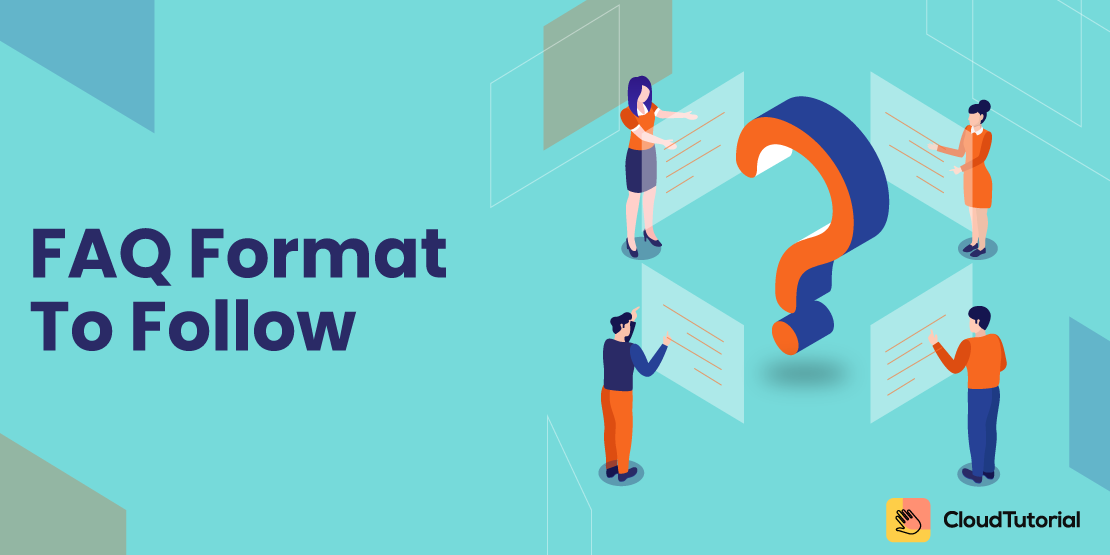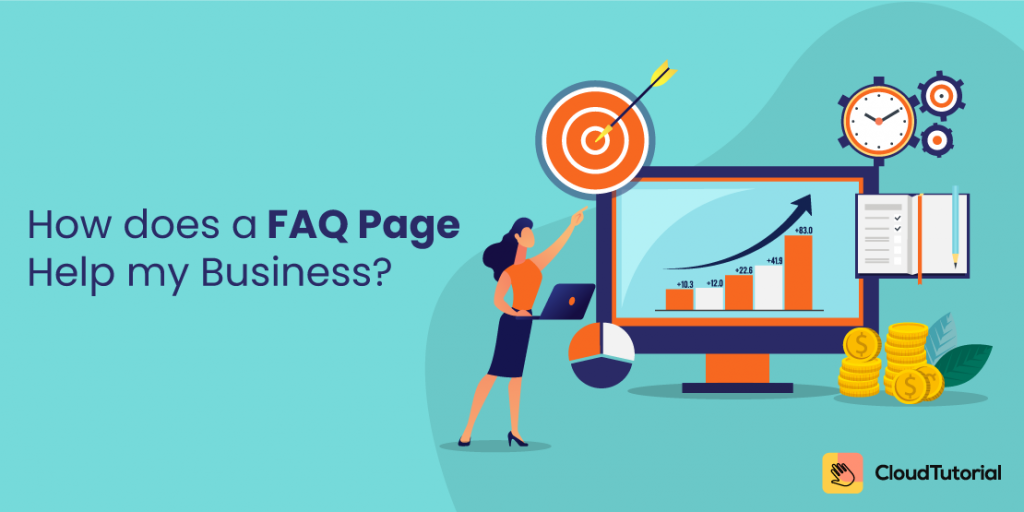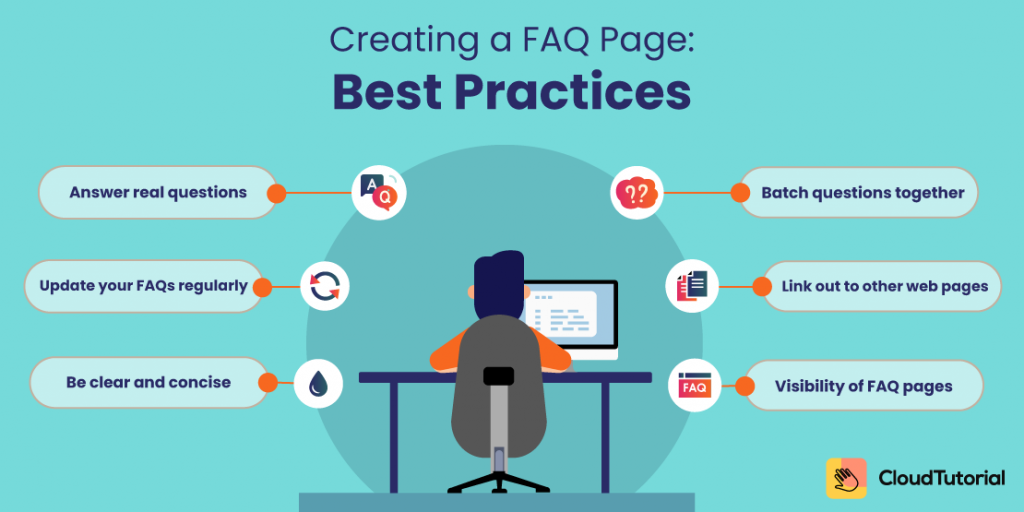As we all know that FAQ means frequently asked questions, and such a page addresses the common customer questions. FAQ section covers a variety of topics and saves time for both customers and customer service rep.
With FAQ pages, the support team won’t have to waste their time on common questions that can get answered through a regulated response. It will also save time for the customers as they won’t have to wait for customer support to answer their questions.
FAQ pages are essential parts for handling customer interactions. To know more about creating a FAQ page, what FAQ format to use, continue reading this blog.
Table of Content
Goals Your FAQ Pages Should Achieve
- It Should Improve User Experience
An effective FAQ lets your customers find the commonly asked questions and answers quickly. Having to go through different pages to find their questions and answers can be annoying for the users.
Your FAQ section should have the answers to every possible question. It should be a repository to find answers to many possible common questions.
- FAQ Page Should Help Customers in Navigation of the Site
The answers to questions may not be easy to find for the customers on a website. Your FAQ section should point them in a way where they can find answers to questions. It can be a blog post, a product page, or a whitepaper that they might not find on the site.
Your faq pages should have links to related articles as it will provide a better website experience to users. It will also boost your link-building, which is essential for ranking on SEO.
- It Should Be Great for Organic Search
Your FAQ page should cover not just your business, product, or service but also your competitors and industry as a whole. It will bring those people who have no clue of your business but found their answers on your website through search results.
FAQ pages can also get used in capturing voice search queries. They are suitable for those questions that are long and phrased in a conversational style. Such format can get inserted into FAQ pages instead of websites where they might feel out of place.
- Your FAQ Should Get Selected as Featured Snippets
Your website will see an increase in traffic if your FAQ page gets selected in Featured Snippet by Google. Featured Snippet highlights those contents that provide a direct answer to the user’s query.
It’s a search result that gets featured on the top of Google’s live results below the ads in a box. Link clicks are much higher on a site if it gets selected on featured snippets.
- Reduces the Cost of Maintaining Support Team
Your frequently asked questions should provide answers to the most common questions. It will save time for your customer support, who can use this time in providing solutions for more complex issues. It will reduce the cost your company spends on the help center.
- A Good Source for Content Ideas
Your FAQ should provide value to your customers. It can be answering questions, solving problems, or improving customers’ experiences. FAQs is one of the best pages for content ideas as it contains questions or issues for which users are looking for solutions.
- Establishes Trust and Brings more Conversions
Having an FAQ on your website shows your commitment to helping your customers in finding solutions. It will create a sense of trust among the customers for your business. Comprehensive answers to questions will also show your thought leadership and expertise in the industry.
Your customers will feel more confident in conducting business with your company.
- Continually Evolves
Your FAQ should continuously evolve to address customers’ interactions and concerns. It should not remain static. Add most up-to-date information on your FAQ page, even if it’s a small one. Your customers should be aware of if there is a change in your policy or product.
- Provides a Better Understanding for Customer Service
You will get a better insight into your customers’ desires, challenges, and needs when you try to identify questions that can provide solutions to their problems. It will shape every aspect of your business, from product development to customer service and marketing.
FAQs will also allow you to explain your services and products to your customers.
Build an advanced knowledge base for your customers and give them answers fast – real fast.
Take your app and help center to the next level with CloudTutorial.
FAQ Formats for your Business
There are no general FAQ formats that you can use for your brand. Each brand has a different type of FAQ. Although, there are specific guidelines that everyone follows while designing their page. Here are six points that you need to keep in mind while creating your FAQ page.
- Write Clear and Concise Pages
Your FAQ page doesn’t need to have long and persuasive paragraphs. It can confuse the audience when they try to search for the answers they need. Be brief and straightforward in your answers. - Keep Updating your Pages
Your FAQ page should show the changes whenever there is an update to products or services. It’s essential to keep the information on your FAQs accurate. Companies should continually review their pages and update them as per the new changes. - Include a Search Functionality
Formats such as listing your FAQ questions on a single page or linking them from landing pages can become tedious for many users. They may visit your FAQ page for a single question and don’t want to go through the entire list of other questions.Including a search bar will ensure that your users can easily search for their queries or related keywords.
- Organize Sections by Category
You can divide the questions into different categories. Listing the questions in random order can be tedious and also frustrating for your users. What if they are searching for questions that are part of the same topic?Categorizing your FAQ will make it easy for them to find their queries under different categories.
- Link your Top Questions
Your page may have some questions that are more common than others. These top questions can have their sections and links to their answers. Your customers will save even more time if you place these questions at the top of your FAQ page.Thus, you will be maintaining your categories while simultaneously making your top questions more accessible.
- Keep your FAQ Basic
FAQ format should be basic at best. Your customers aren’t visiting the FAQ page for entertainment. They are there to find answers to their questions, so you should keep the design simple.Don’t use too much humorous language or colorful themes, and focus on making your FAQ pages more accessible and easy to read. Stick to basics.
Creating a FAQ Page: Best Practices
FAQs need to be straightforward and easily accessible for the customers. Here are some of the best practices that you can adapt to your FAQ page.
- Keep your customers in mind when writing questions for your FAQ page: Write it as the reader asks, choose a format that reduces confusion, and matches what people type in search engines.
- Keep answers clear and concise: Try to keep the paragraph short, less than 100 words. People prefer straight to the point answers.
- Your answers should start with a yes, or a no for yes/no questions: A definitive answer (yes/no) feels more confident and can save people’s time.
- Add some personality to the answers: Use your brand’s voice and avoid writing in dull language.
- Use frequently asked questions or FAQ for the page title: Don’t try to overcomplicate by calling it with different names. You can also place it on your contact page.
- Use the question-answer format for your FAQ pages: Write actual questions and answers. Don’t try to make it an about us page.
- Give a straight answer instead of just providing a link to a separate page: Try to answer every question without linking it away to another page. Links are acceptable for providing more information, but the answer should be on the same page.
- Don’t use jargon: Use vocabulary and phrases that your customers are familiar with on your faq page.
How to Create a FAQ Page?
CloudTutorial is an ideal platform to create a FAQ page for websites. You can create your page in just five easy steps:
Step 1: Visit CloudTutorial website and signup to create your account.
Step 2: Analyze what kind of features you need for building your FAQ page. It will help you in choosing the right plan as per your needs.
Step 3: Go through CloudTutorial’s pricing section for the plans that the platform offers. Each comes with different features. Choose the one that feels right for building a great FAQ page.
Step 4: Fill in all the details to begin working on your page.
Step 5: Choose a display name for the website. You can even upload Site Favicon and logo, although it’s optional.
CloudTutorial lets you invite others to manage your FAQ. It allows you to give them roles as per your needs. You can add separate categories and subcategories for your page to make the navigation easy for customers.
You can also link your FAQ page with your knowledge-base articles. There are options to keep the comment section open and add hashtags to make the content easy to search in the search engines. It has Google analytics for tracking the performance of the page.
That’s how easy it is to develop FAQ pages with CloudTutorial.
Build an advanced knowledge base for your customers and give them answers fast – real fast.
Take your app and help center to the next level with CloudTutorial.
FAQ Page Template
Here are some examples of the common questions that get used in FAQ pages of every industry. These questions should give an idea of how an FAQ template looks like, although there is no general FAQ template to follow.
- What shipping options does the company provide?
- When will I receive my order?
- What to do if the product is defective?
- Where is the business located?
- How do I contact the support team if my question doesn’t get answered in the FAQ section?
- How to make changes to an order that already gets placed?
- What materials are you using to make the product? How does it get made?
Make sure to let your customers know that their information is secure and private. You can also try to address the common questions regarding the safety of using the product.
Your FAQ page should also help the customers in how to use the product. Answer questions that revolve around getting started and resolving any problems that customers may face when using it for the first time. Here is an example.
- Reflects your customer’s requirements
- Continually updates to reflect changes in the products or services
- Shows your expertise, authority within the industry, and trust
- Brings new users to the website by providing solutions to their problems
- Fuels content creation
- Your business and refund policies
- Which regions do you ship?
- How fast you fulfill orders
- Facts about your services and products
- How the customer can choose the right product
- Clearing out any confusion regarding the product or services
Your FAQ page should be discoverable in the customer journey. That’s where you can get the most out of the page. It should be a part of your contact us, navigation menu, or support page where it gets found easily.
FAQ pages bring a lot of value in various ways, such as addressing the purchasing anxieties. It also reduces the burden on the support team.
If you don’t have a FAQ template for your site, now is a great time to give cloudTutorial a try. It has both paid and free plans, which you can use for creating a faq page for your website.
Try it out before you decide.
Create a test article NOW!
Using this tool, all you have to do is add your first test article and see how it looks. Now, you don’t have to sign-up or login into CloudTutorial software just to check how your first article appears.



